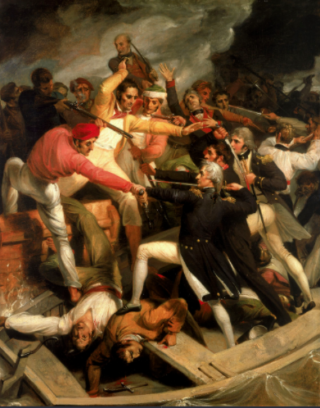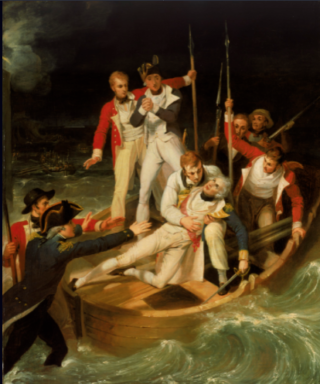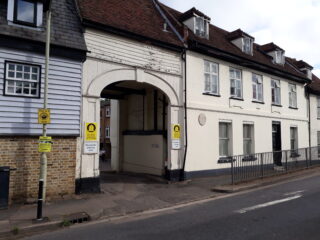A Painter of the Dramatic and Heroic: Richard Westall
Susan Payne
West Street, Hertford
These paintings are part of a series showing Admiral Nelson’s life as a series of heroic acts. They were commissioned by the author to appear in the first major biography of Lord Nelson published in 1809. The artist, Richard Westall, was making the most of the patriotic wave following the Admiral’s death at the Battle of Trafalgar four years before. Westall had lived in Hertford as a boy and went on to acclaim as a painter and illustrator.
Benjamin Westall moved his family from Norfolk following the death of his wife and the bankruptcy of his brewery. For the next 7 years, until he was aged 14 Richard stayed with his family at the brewery buildings in West Street.
Training at the Royal Academy
The art in vogue at the time was for literary and historical subjects, usually showing a moment of action in a fictional story or historic event. Richard’s training at the newly created Royal Academy School prepared him for success as a painter of scenes from Shakespeare, Milton and Sir Walter Scott. Westall exhibited at the Academy regularly throughout his life and was elected an Academician in 1794.
Westall was soon attracting attention in the English art world. The politician and art historian Horace Walpole described his work as ‘by far one of the finest compositions ever painted in England’. Though critics such as Anthony Pasquin wasn’t so impressed: ‘This is such an effort, as no person, possessing taste and knowledge, can regard with satisfaction; yet it involves that trickery and finery which is so captivating to vulgar minds’.
Major London exhibition
On the whole, the public were on Westall’s side. Paintings illustrating popular subjects like Byron’s Don Juan and of course Admiral Lord Nelson, were widely available through cheap prints. When an exhibition in 1814 displayed a collection of over 300 of Westall’s pictures, the catalogue listed the owners who had loaned paintings. This showed how Westall’s work had found its way into many of the best collections in the country, including the earls of Oxford, Carlisle, and Harrowby, also Byron and the Prince Regent.
The exhibition marked something of a high point for Westall. As the 19th century progressed artistic tastes moved away from the romantic and historical styles. From this point the number of painting commissions reduced and he turned book illustration, becoming one of the most prolific artists of the day. Advances in book production and a wider readership led to a rapidly growing market. Editions of the Bible, Shakespeare and Milton were all published with Westall illustrations.
Drawing Master to Royalty
Almost bankrupt, he considered leaving for the Continent where his reputation remained high. However, in 1827 he was appointed as Princess Victoria’s first drawing master. He taught the eight year-old twice a week for the next 9 years. As Queen Victoria she recalled Westall as “a very indulgent, patient agreeable master, and a very worthy man.”
He died on 4 December 1836 at his home in Fitzroy Square, London. Westall was a significant and innovative figure in the development of the English painting, his elegant and precise book illustrations set new standards in that field. He was a leading artist for some twenty years.
Examples of Westall’s work are in Sir John Soane’s Museum, the National Maritime Museum and the National Portrait Gallery.





Add your comment about this page